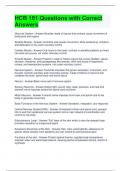HCB 101 Questions with Correct
Answers
Muscular System - Answer-Muscles made of tissues that contract cause movement of
body parts and organs
Skeletal Muscle - Answer-Contracts and causes movement, allow swallowing, urination,
and defecation to be under voluntary control
Cardiac Muscle - Answer-Only found in the heart, contract in wavelike patterns so heart
can work as a pump, not under voluntary control
Smooth Muscle - Answer-Present in walls of hollow organs like urinary bladder, uterus,
stomach, intestines, and passageways like arteries, veins and tracts of respiratory,
urinary, and reproductive systems, not under voluntary control
Nervous System - Answer-Transmits impulses that govern sensation, movement, and
thought, controls voluntary and involuntary activity, made of billions of neurons that
comprise the brain, spinal cord, and nerve tissue
Neuron - Answer-Basic nerve cell of nervous system
Sensory Neurons - Answer-Detect light, sound, odor, taste, pressure, and heat and
transmit nerve impulses toward the spinal cord and brain
Motor Neurons - Answer-Transmit nerve impulses from brain and spinal cord to the
body to generate movement
Basic Functions of the Nervous System - Answer-Sensation, integration, and response
Central Nervous System(CNS) - Answer-Comprised of brain and spinal cord, process
info to and from peripheral nervous system and is main network of coordination and
control for the body
Subcutaneous Layer - Answer-"Fat" layer of the skin which is also the deepest layer,
provides insulation for integument layers
Accessory Structures of the Skin - Answer-Hair, nails, sweat glands, sebaceous oil
glands, blood vessels, from epidermis but can extend to subcutaneous layer
Functions of the skin - Answer-Protect against trauma, regulate body temperature,
maintain water and electrolyte balance, sensing painful and pleasant stimuli, vitamin d
synthesis
, Skeletal System - Answer-Foundational framework that muscles, tendons, and
ligaments attach to, allow movement and support as well as protection for organs, 206
total bones
Axial Skeleton - Answer-Vertical, central axis of the body to include all bones from head,
neck, chest, and back, 80 bones
Anatomical Position - Answer-Refrence Position in Anatomy. Upright, Arms Hanging
with palms forward, thumbs away with feet pointing forward
Anatomical Planes - Answer-Imaginary planes that divide the body
Anatomy - Answer-Study, classification, and description of organs
Anatomical Regions - Answer-Areas of the human body defined by landmarks
Directional Terms - Answer-Describe positions and relation of various structures of the
body
Gross Anatomy - Answer-Study of larger structures (seen with the naked eye)
Homeostasis - Answer-Process used to maintain stable conditions for survival
Microscopic Anatomy - Answer-Study of structures that can only be seen with a
microscope or other devices
Physiology - Answer-Scientific study of chemistry and physics of the body structures
What are the Six levels of Organization in the Human Body? - Answer-Chemical,
Cellular, Tissue, Organ, System, Organismal
Chemical Organization - Answer-Beginning level, subatomic particles, atoms, molecules
Cellular Organization - Answer-Smallest, most numerous structural unit
What are the 3 main parts of a cell? - Answer-Plasma membrane, Cytoplasm, Nucleus
Tissue Organization - Answer-Similar Cells grouped to perform a specific function. 4
main parts
What are the 4 main parts of Tissue Organization? - Answer-Epithelial, Connective,
Muscular, Nervous
Epithelial Tissue - Answer-Forms outer covering of the body and lining of different body
systems.





